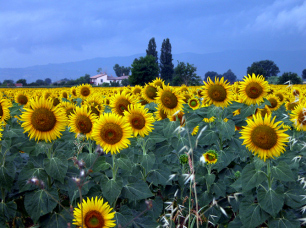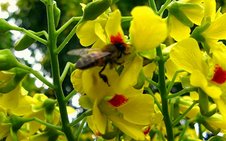THE BOW IN THE TREE
As already mentioned in the previously posted blog, exception made for rough construction errors by the craftsman, all bows that show a torsion surely turn the head towards left, and in order to explain you why it may occur, I will ask for help to a plant that apparently has little to share with bows : “The sunflower”.

As we all know, sunflowers take their name from their property to follow the sun during the whole day. At dawn, they have the flower turned towards east then, with the proceeding of the day, it moves following the sun until it turns to the west for the sunset , when the solar attraction decreases and then it newly returns back to the east. This behaviour is called “Eliotropic”. I have taken the sunflowers as an example because, even if less evident, the “Cesalpina Echinata”, aka “Pernambuco”, has a behaviour that is very close to the Eliotropic one.
A pernambuco tree takes 70-80 years to reach its maturity and be ready for the cut, this is to say that in its life, it will see approximately 30.000 dawns and as many sunsets, and the solicitation exercised from the solar attraction every day, induces in the very elastic fibers of this wood a torsion towards the west; i.e. is towards right.
You may ask: “But if the torsion is towards right (the West), why does the bow turn its head towards left (East)”.The reason is very simple, and it is the reason why the seasoning of the wood plays a fundamental role in any construction way.
Pernambuco must season from four to six years as a trunk, two when converted in a table, one as a stick , and two or three months after, for instance, the first polishing proceed .
As already told, the bow is a spring , and pernambuco is used for the making of bows just because its fiber is nervous and stiff as a spring. When you put a spring under charge, the coils are wrapped on , but when you remove it, they come back to the starting position. The same thing happens to the wood.
Until the stick is not put under work, the wood mass keeps the spring under tension, but when with the plane begins to remove material and the structure is lightened, the tension decreases and the fiber begins to return to its the original position rotating in a direction that is juxtaposed that one of the sun; i.e. towards east.
In the polishing phase in fact, after having carried out the octagon and the first fold, the stick is left to rest in a round and not octagonal shape . This operation is carried out to allow the wood to settle freely , and since the stick will not move anymore, the craftsman will be able to go on carrying out the definitive octagon; the ability lies in understanding when the right moment is reached.
Also the torsion, even if a little bit tougher than direction, is a defect that in most cases can be removed from the bow in an easy way, if the bow maker is a skilled one . The next week we will start to speak about the serious problems that a bow can show: those one related to the curve.
For those one wishing further information about pernambuco wood, click on tthe picture and visit the relevant Wikipedia page.

So long
Paolo
|